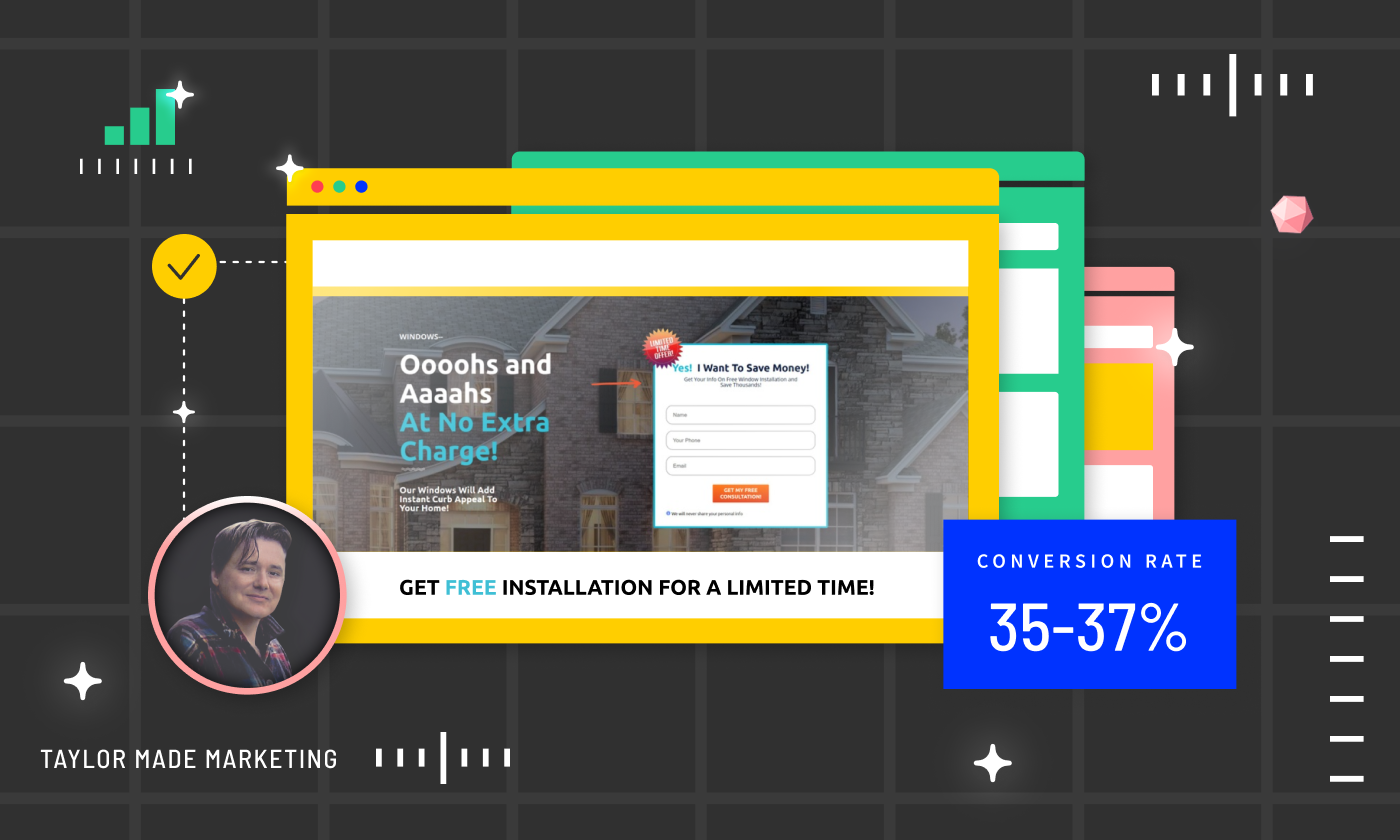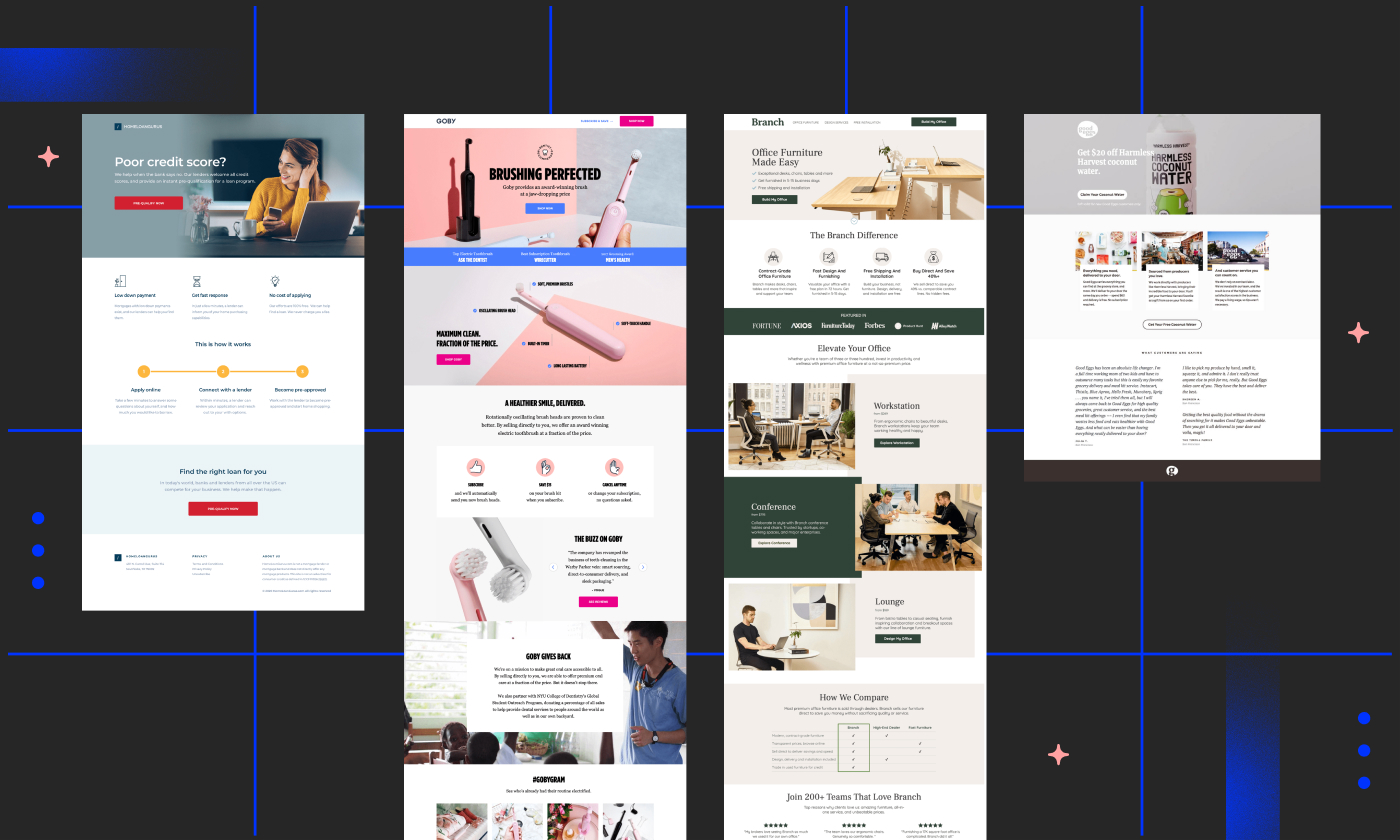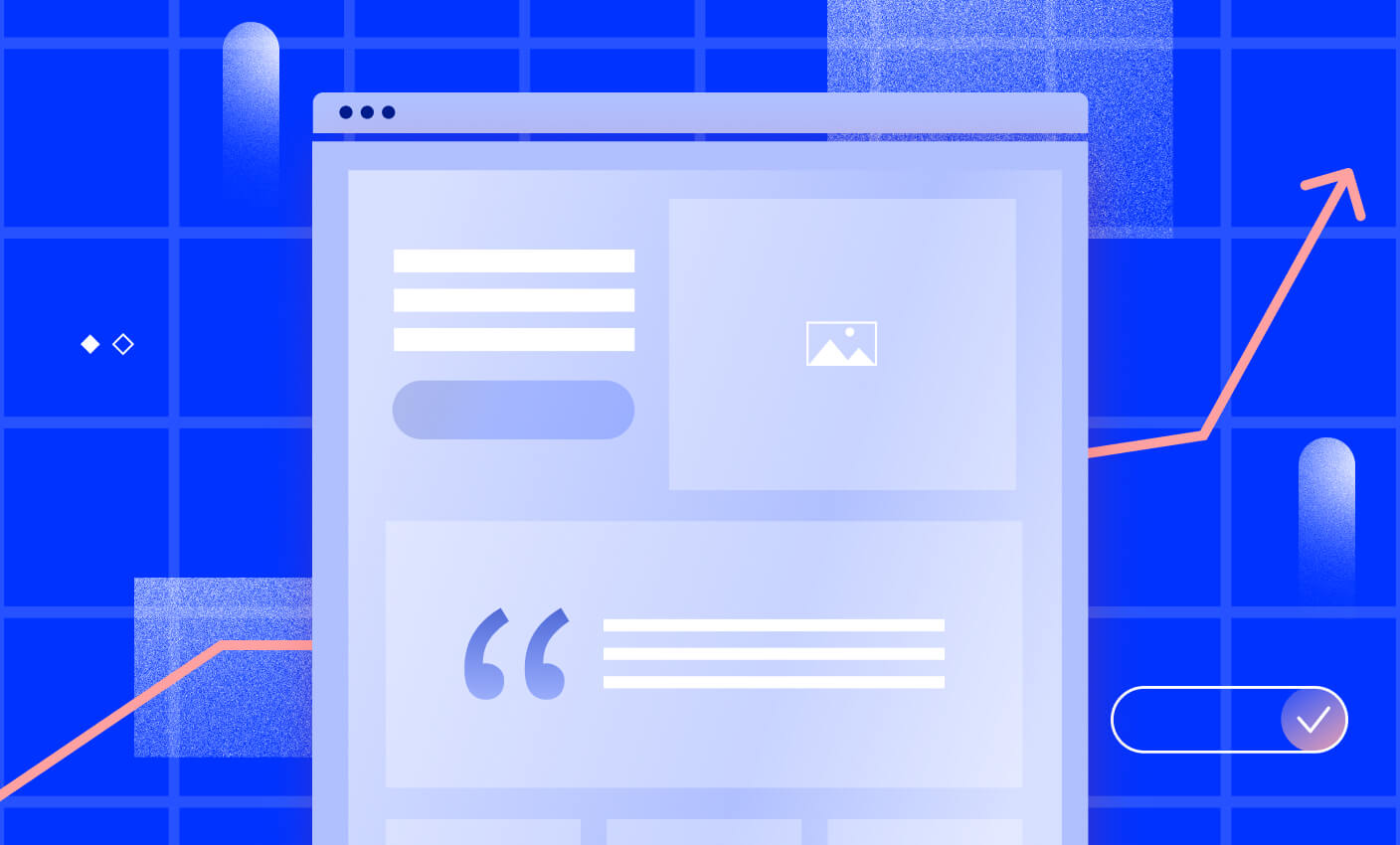
Lead generation for marketing agencies: 9 actionable strategies
Marketing agencies need one thing to succeed long-term:
Qualified leads.
Yes, there’s a lot more to running a successful marketing agency than just leads, but none of it matters if the pipeline is sitting at $0.
Which begs the question:
How do you get more leads for your marketing agency?
In this article, we’re sharing 9 different agency-focused lead generation strategies you can experiment with, plus a few common mistakes to watch out for.
TABLE OF CONTENTS
Inbound vs outbound lead generation: Which is best?
First thing’s first, let’s top-line the two primary approaches to agency lead generation:
Inbound and outbound.
The strategies below focus mainly on inbound lead generation, but by no means is that to say outbound can’t work, too. Here’s a closer look at each before we get started:
Inbound lead gen: Hand-raisers coming to you
Inbound lead generation is all about making it easy for potential clients to find you.
It works like this:
People who are already looking for services like yours find your content through search engines, social media, or referrals. They come to you because they’re already interested. This approach is great for building credibility and trust over time. By creating valuable content and optimizing your website for search engines, you can attract leads who are actively seeking solutions.
When inbound lead generation is a good fit:
- Great for growing your reputation with helpful content and showing up in searches.
- Use it to attract folks already looking for what you provide.
- Perfect for getting leads through your website and by sharing valuable info.
For example, a digital marketing agency might create informative blog posts or videos that answer common questions potential clients have. When someone searches online for those topics, they find the agency’s content and may contact them for more information or services.
Outbound lead gen: Ideal fit prospects that don’t know you
Outbound lead generation is more proactive.
Instead of waiting for clients to come to you, you go out and find them. This could mean reaching out via cold emails, running targeted advertising campaigns on platforms like LinkedIn or Google Ads, or attending industry events to network and make connections. Outbound strategies are effective when you want to expand your client base quickly or target specific industries or demographics.
When outbound lead generation is a good fit:
- Use it to target exactly who you want to work with or in new markets.
- Perfect for getting quick interest and contacting potential clients directly.
- Great for starting conversations with people who haven’t found you yet.
For example, a marketing agency might run a cold outreach campaign using a blend of email and LinkedIn DMs. They target a group of ideal-fit prospects who match their target client criteria, proactively reaching out to potential clients who may not have heard of them before.
Recommended reading: How this marketing agency uses AI to 10x their conversion rates
What makes agency lead generation different from other business types?
When generating leads for a marketing agency, the approach can be quite different compared to other business types like eCommerce or SaaS. These differences stem from the nature of services offered and the relationship-building required. Let’s explore three main differences.
Relationships matter in agency sales
Building strong, trust-based relationships is crucial in agency lead generation.
Unlike ecommerce or SaaS companies, where transactions are often one-time and quick, agencies thrive on long-term engagements. You must demonstrate expertise and reliability to potential clients, requiring more personalized interactions and ongoing communication.
Services and offers are more frequently customized
Marketing agencies often provide highly customized solutions tailored to each client’s unique needs. This contrasts again with ecommerce or SaaS businesses that typically offer standardized products. Therefore, lead generation efforts must focus on how you can understand and adapt to each prospect’s specific challenges and present bespoke solutions, making the sales cycle longer and more consultative.
Demonstrating expertise is key as you’ll be helping with strategy and implementation, not just selling a product
Once again, because agencies generally aren’t just delivering a product like a random Amazon vendor, your expertise must shine through—not just the “product” itself. Potential clients want proof that you know what you’re doing and can deliver results.
Because of this, agency lead generation usually involves creating content highlighting successful campaigns, your unique points of view and processes, and demonstrating your agency’s value.
Recommended reading: 10 creative lead gen examples sourced from marketing legends
9 actionable strategies to generate leads for your marketing agency
Generating leads for your marketing agency requires a mix of creativity and strategy. Here are a handful of actionable strategies that can help you attract and convert new clients, starting with one that’s near and dear to our hearts—lead generation landing pages.
1. Create landing pages with lead generation forms
Landing pages are dedicated pages designed to capture information from visitors, typically through forms. These pages focus on a single goal: converting visitors into leads by collecting their contact details in exchange for valuable content or offers.

Example from KlientBoost
Why it works
- Landing pages focus on one specific offer or call to action.
- You can optimize each landing page to maximize conversion rates.
- Targeted messaging on each landing page is tailored to specific campaigns, product areas, or audience segments, making it more relevant to prospects.
- Lead qualification forms can gather detailed information, helping qualify leads.
How to implement the strategy
- Choose a landing page builder: While you technically can build pages without one, a dedicated landing page builder (like Unbounce) will make the process 1,000x faster, easier, and more effective than trying to code everything yourself.
- Define the goal: Determine what you want to achieve with the landing page (i.e. collecting email addresses or sign-ups for a webinar).
- Build the page: Use a clean, simple layout with a clear headline and a strong call to action (CTA). Ensure the form is easy to find and fill out. If you’re using Unbounce, you can start from a lead generation landing page template here as well.
- Optimize the form: Keep it short and ask only for essential information. Use fields that help qualify leads (i.e. company size, job title).
Focusing on these elements can help you create effective landing pages that capture high-quality leads and drive your agency’s growth.
Recommended reading: This marketer turned cookie-cutter landing pages into 120,000+ leads: find out how
2. Iteratively test your most important landing pages
The best agency lead generation engines involve constant experimentation and optimization. The moment you stop testing your landing pages will be the moment your growth starts to stagnate.
Optimizing your landing pages is not a one-time task.
You need to iteratively test and refine your pages to continuously improve performance. This involves making changes, measuring results, and adjusting based on what you learn. The goal is to find the best combination of elements that drive conversions.

Example from Campaign Monitor
Why it works
- Continuously improves conversion rates by refining elements based on performance.
- Boosts conversion rates by making it simpler for visitors to take action.
- Improves clarity and relevance of messaging, making it more persuasive.
- Leans on actual data and user behavior to adjust important elements on your landing pages and positioning.
- Reduces guesswork by providing clear insights into what changes make the biggest impact.
How to implement this strategy
- Use an A/B testing platform: Start with a tool that lets you quickly ship new page variants and run experiments. We just so happen to know a pretty great A/B testing tool that fits the bill here—it starts with “U” and ends with “nbounce”.
- Identify key elements to test: Focus on components like headlines, CTAs, images, and form fields. These elements you can test typically have the most significant impact on conversions.
- Create hypotheses: Before making changes, hypothesize what you believe will improve performance. For example, you might think a shorter form will lead to more conversions. We’ve found peeking at other landing page examples to be good sources of inspiration for experiments.
- Design variants: Based on your hypotheses, create different versions of your landing page. Ensure each variant tests only one element at a time for clear results.
- Run the tests: Launch your A/B tests and direct traffic to the different variants. Collect data over a sufficient period to get reliable results.
- Analyze the results: Use analytics to determine which variant performs better. Look at conversion rates, bounce rates, and other relevant metrics.
- Implement the winning changes: Once you identify the best-performing variant, implement those changes permanently. Repeat the process with new elements to continually optimize your pages.
- Run more tests: The key to a winning experimentation strategy is to never stop testing. There’s always more to learn and more to experiment with. Just keep going.
By iteratively testing your landing pages, you can refine your strategy and ensure that you always use the most effective designs to convert visitors into leads.
Recommended reading: How a three-word A/B test led to triple-digit conversion growth
3. Create high-quality content to educate and entertain prospects
Publishing (genuinely helpful) content is one of the most powerful ways to attract and engage potential clients. This content can take many forms, including blog posts, videos, webinars, and infographics.
The goal is to provide valuable information that addresses the needs and interests of your target audience, positioning your agency as an expert in the field.

Example from Backstage SEO
Why it works
- High-quality content builds trust and credibility by demonstrating your expertise.
- Content can attract organic traffic through SEO, social media, and more.
- Engages prospects by addressing their pain points and interests.
- Encourages visitors to spend more time on your site, increasing conversion opportunities.
How to implement this strategy
- Identify your target audience: First, make sure you have a solid definition of who your ideal clients are and what problems they have that you can help solve.
- Research content ideas: Check tools like Google Trends and SparkToro, and visit niche subreddits in your industry to find trending topics and common questions.
- Create a content calendar: Plan your content in advance to ensure consistency and alignment with your marketing goals.
- Produce high-quality content: Create in-depth, well-researched pieces that provide real value. Use a mix of formats like articles, videos, and infographics. With Unbounce, you can use our AI copywriting tool, Smart Copy, to help as well.
- Optimize for SEO: When it’s applicable, use relevant keywords, meta descriptions, and internal links to improve search engine rankings and content discoverability.
- Promote your content: Share your content across multiple channels like social media, email newsletters, and industry forums.
- Analyze and adjust: Track the performance of your content and make adjustments based on what works best to engage and convert your audience.
By consistently producing and promoting high-quality content, you can attract and nurture leads and ultimately convert them into loyal clients for your agency.
4. Launch gated assets and “content upgrades” to convert readers into leads
While creating high-quality, ungated content is essential for attracting visitors and engaging them, you can take your strategy a step further by using gated assets and content upgrades. These tools can help convert your readers into inbound leads that you can nurture and reach out to directly.

Example from FAME
Why it works
- Turns readers into leads by offering additional value in exchange for information.
- Creates inbound hand-raisers that willingly give you their contact information, allowing you to directly follow up when intent is high.
- Opens the door for future remarketing and lead nurturing campaigns.
- Increases perceived value by offering exclusive, high-quality content.
How to implement this strategy
- Identify opportunities for gated content: Look for popular topics in your ungated content that could benefit from deeper dives or additional resources.
- Develop gated assets: Create valuable downloadable content like eBooks, white papers, templates, and checklists. Ensure these assets are closely related to the topics of your ungated content.
- Introduce content upgrades: A content upgrade is a specific type of gated asset directly tied to an existing ungated content page. For example, an article on creating a customer journey map might offer a downloadable customer journey map template.
- Add gated content to your website: Place forms or call to action (CTA) buttons within ungated content to offer the gated asset or content upgrade. Use clear calls to action that explain the value of the download.
- Optimize your forms and CTAs: Keep forms simple and only ask for essential information to reduce friction and increase conversions.
- Promote your gated assets: Use email campaigns, social media, and other marketing channels to drive traffic to your gated content.
Gated assets and content upgrades can turn a traffic-focused content strategy into a lead generation engine—which is ultimately what you’re after if generating leads and closing deals is the goal. These assets can convert your readers into hand-raisers, ready to be nurtured via email marketing efforts.
Recommended reading: This SaaS collected 100k+ leads using gated content & landing pages
5. Publish content on LinkedIn to reach “cold” prospects
Using LinkedIn to build credibility in your industry and reach potential clients can be highly effective, especially when you use personal accounts rather than brand pages.
LinkedIn is all about people and personal relationships. By sharing content from internal “thought leaders” like your agency’s founders or key leadership team members, you can build relationships and establish authority in the industry.

Example from Anthony Pierri
Why it works
- The percentage of users actively publishing content on LinkedIn right now is far lower than other platforms, reducing the competition for attention.
- Builds personal connections that foster trust and credibility.
- Positions you and your key team members as industry experts, enhancing your agency’s reputation.
- Increases visibility through the networks of your personal connections.
How to implement this strategy
- Identify internal thought leaders: Choose key team members who have valuable insights and a strong professional presence, like founders or senior leaders.
- Create valuable content: Develop content that addresses industry challenges, shares success stories, hits on trending topics, showcases your expertise and unique POVs, and provides actionable advice.
- Optimize LinkedIn profiles: Treat your LinkedIn profiles (including the company page) like landing pages. As you share content, your photo and company logo will get clicked and prospects will land on your profiles. Optimize that experience to convey authority and credibility, and funnel prospects toward your actual landing pages or DMs.
- Publish regularly: Commit to publishing at least 3 times per week. The key to long-term success on LinkedIn is consistency. If you just drop a bundle of posts one week then go into hiding for months, it’s not going to work.
- Engage with the audience: Respond to comments, participate in discussions, and connect with new contacts. Building these relationships can turn cold prospects into warm leads over time.
Using personal LinkedIn accounts to share valuable content can help your agency connect with potential clients on a more personal level, building relationships that can lead to new business opportunities.
Recommended reading: The complete beginner’s guide to advertising on LinkedIn
6. Experiment with high-intent PPC campaigns
High-intent PPC (pay-per-click) campaigns target audiences who are more likely to convert because they have shown specific interest in your services. This means focusing on precise audiences, such as retargeting prospects who have already visited key pages on your site or targeting specific search terms related to your service lines, like “video production agency”.

Why it works
- Targets prospects who are closer to making a decision, which makes them more likely to convert.
- Maximizes ad spend by focusing on high-value keywords and audiences.
- Provides measurable results, allowing for continuous optimization.
- Enhances visibility among potential clients actively searching for your services.
How to implement this strategy
- Identify high-intent keywords: Research and select keywords that potential clients use when looking for services you offer. For example, target search terms that include modifiers like “agency” or “services” and broader matching terms that relate to your specific type of agency like content or video.
- Design targeted landing pages: Ensure that your PPC landing pages are tailored to the high-intent keywords or audience segments. They should be optimized for conversions with clear CTAs and relevant content.
- Set up retargeting campaigns: Use retargeting to reach visitors who have already engaged with your website, particularly those who visited key pages but did not convert.
- Create compelling ad copy: Write clear, persuasive ads that address the specific needs and pain points of your high-intent audience. You can speed up this step with Unbounce’s URL to ads tool to automatically generate optimized ad copy with AI using only your landing page URL.
- Monitor and optimize: Regularly review the performance of your PPC campaigns. Use analytics to track metrics like click-through rates (CTR) and conversion rates. Adjust your strategy based on what’s working best.
Focusing on high-intent PPC campaigns can help you reach prospects who are already interested in and looking for your services, meaning more precise ad spending and higher quality visitors reaching your landing pages.
Recommended reading: How Indochino used landing pages creatively to maximize ad spend (retail marketing case study)
7. Optimize your website to rank organically in Google for solution-focused searches
Along with targeting high-intent “agency” type searches with ads, you can optimize your website to rank for those same terms organically over time. By improving your site’s SEO and creating content that aligns with what your potential clients are searching for, you can attract and convert high-intent visitors without relying solely on paid ads.

Why it works
- Attracts high-intent visitors who are actively searching for your services.
- Builds long-term visibility and credibility in search engine results.
- Reduces dependence on paid advertising by generating organic traffic.
- Provides ongoing opportunities for lead generation through evergreen content.
How to implement this strategy
- Identify target keywords and topics: Research and select high-intent keywords that your potential clients are using to find services like yours. Just like the last strategy, focus on high-intent terms that include modifiers like “agency” or “consultant” in them.
- Create and optimize content: Develop high-quality content that addresses the needs and questions of your target audience. Use your target keywords naturally throughout your content, including in titles, headers, and meta descriptions.
- Optimize on-page SEO: Make sure your website and content follows the SEO basics like optimizing title tags, meta descriptions, headings, and URL structures. Make sure your site is also mobile-friendly and has fast loading times.
- Add internal links: Create a strong internal linking structure that helps search engines understand the hierarchy and relevance of your pages. Link related content to guide visitors through your site.
- Earn backlinks: Work on building high-quality backlinks from reputable websites. This is easier said than done, but focus on creating shareable content that others will want to link to first and foremost.
- Monitor performance: Use tools like Google Analytics and Google Search Console to track your rankings and organic traffic. Regularly review your performance and make adjustments as needed.
- Update and refine content: SEO is an ongoing process. Continuously update your content to keep it relevant and useful. Add new information, update keywords, and refine your strategies based on what’s working.
Optimizing your website to rank organically for high-intent searches can attract a steady stream of potential clients who are actively looking for the services you offer—without you needing to swipe your credit card every month.
Recommended reading: How to rank (and convert) with landing page SEO
8. Launch a referral program for existing clients or partners
A referral program uses your existing clients, partners, and fans to bring in new business. You can tap into a valuable source of high-quality leads by incentivizing your current clients and partners to refer others to your agency. This strategy builds on the trust and satisfaction of your current relationships, making it a powerful tool for lead generation.
Why it works
- Uses trust and satisfaction of existing clients to attract new business.
- Provides high-quality leads who are pre-qualified by your referrers.
- Enhances client loyalty by rewarding referrals.
- Expands your reach through word-of-mouth and personal recommendations.
How to implement this strategy
- Define your referral program goals: Determine what you want to achieve with your referral program, such as increasing lead volume, improving lead quality, or entering new markets.
- Create attractive incentives: Offer rewards that motivate clients and partners to refer others. These can include discounts, free services, gift cards, or cash bonuses.
- Communicate the program: Clearly explain the referral program to your existing clients and partners. Use email newsletters, direct communication, and your website to share the details and benefits.
- Simplify the referral process: Make it easy for clients to refer others by providing a straightforward process. This can include online forms, referral links, or a dedicated email address.
- Track and manage referrals: Use a CRM or referral management software to keep track of referrals and ensure they are properly rewarded. Monitor the success of your program and make adjustments as needed.
By launching a referral program, you can leverage your existing clients’ and partners’ trust and satisfaction to attract new, high-quality leads, helping your agency grow through word-of-mouth and personal recommendations.
9. Get listed as a verified vendor on reputable directories
Being listed as a verified vendor on reputable directories can significantly boost your agency’s visibility and credibility. These directories are often the first place potential clients look when searching for trusted service providers. Getting your agency featured can drive high-quality leads to your business.
For example, getting listed on directories like Unbounce’s verified agencies directory can be a powerful lead generation channel for marketing agencies that offer landing page services. When prospects are looking for trusted agencies, they may visit directories managed by brands they already know and trust—like Unbounce—to build their initial consideration set.

Another great example is the Ahrefs SEO agencies directory. Ahrefs is one of the largest brands in the SEO industry, so any agency listed in their directory instantly gets a big trust bump in the eyes of a prospect.
Why it works
- Increases visibility among potential clients actively seeking services.
- Enhances credibility by being associated with well-known and trusted directories.
- Drives consistent traffic to your website from a trusted source.
How to implement this strategy
- Research relevant directories: Identify reputable directories in your industry. Look for those that are well-regarded and frequently visited by your target audience.
- Meet listing criteria: Ensure your agency meets the requirements for being listed. This might include having certain certifications, client testimonials, or case studies.
- Submit your application: Follow the application process for each directory. Provide all necessary information, such as your agency’s services, contact details, and proof of expertise.
- Optimize your profile: Once listed, make sure your directory profile is complete and compelling. Include a strong description, client testimonials, and links to your website and social media.
- Promote your listing: Share your directory listing with your network. Use it as a credibility booster in your marketing materials and communications.
Getting your agency listed on these reputable directories can increase your visibility and credibility, leading to more high-quality leads and growth opportunities.
How to implement a lead scoring and lead qualification system (without making it too complex)
Lead scoring and lead qualification are methods to rank leads based on their conversion likelihood. These systems help to prioritize the best leads, ensuring your sales team focuses on the most promising prospects.
Effective lead scoring can streamline your sales process and improve conversion rates. However, it’s important not to go overboard with overly complex lead scoring systems. Complexity can lead to confusion and inefficiency, making it harder to effectively use the system.
Keeping it simple ensures that your team can easily understand and apply it.
Here’s how to implement a simple lead qualification system that works:
- Define your ideal customer profile: Identify the characteristics that make up your ideal client, such as industry, company size, job role, funding situation, pain points, etc.
- Assign point values: Create a point system for different criteria that match your ideal customer profile. For example, assign points for company size, decision-making authority, level of engagement, and key actions taken.
- Set up scoring categories: Categorize leads based on their score, such as hot, warm, or cold. This helps prioritize follow-up actions.
- Integrate with your CRM: Use your CRM to automate the scoring process. CRM tools can automatically assign scores based on predefined criteria.
- Review and adjust regularly: Periodically review your lead scoring criteria and adjust as needed based on the system’s effectiveness and feedback from your sales team.
Again, keep it simple. By keeping your lead scoring system straightforward, you can efficiently qualify leads and focus on those most likely to become valuable clients without drowning in admin tasks to keep the data updated and risk the system breaking.
Common agency lead generation mistakes to watch out for
Even with the best strategies in place, it’s easy to make mistakes that can hinder your lead generation efforts. Here are some common pitfalls to avoid to ensure your lead generation is as effective as possible.
Focusing on lead quantity over lead quality
Of course, the ideal scenario is high quantity and high quality.
But if you can only choose one of the two, prioritizing quantity over quality is a one-way ticket to wasted investment, sunk time costs, and turbulence in the business.
Quantity over quality isn’t the best approach. It means you’ll generate tons of bad-fit leads. The obvious problem here is that bad-fit leads don’t convert, so your lead generation efforts will never actually result in new business (aka revenue). When you dig even deeper, having to deal with lots of bad-fit leads will also result in tons of wasted time for you or your team talking to leads that are never actually going to convert.
Quality over quantity is far better. It creates the exact opposite effect—less time spent nurturing leads, while simultaneously converting more leads into customers. Even if your cost per lead ends up being higher than it would be if you were focused on volume, your value per lead will far outweigh the extra cost.
Taking too long to respond to inbound leads
Response times matter.
In fact, you’re actually 21x more likely to qualify a lead if you respond within 5 minutes compared to waiting just 30 minutes. If you wait 90 minutes or more, your chances are slim to none.

Far too often, marketing agencies sit on inbound form submissions and requests for a few hours—sometimes even a few days—even though it’s virtually killing their chances of closing the deal before it even gets the chance to grow legs.
At this point, there’s no excuse to let inbound requests sit dormant for more than a few minutes considering how easy it is to trigger automated thank you emails and initial follow ups.
Recommended reading: See how this baby food brand brought in 14,000+ email subscribers
Setting and forgetting their lead generation systems
Above all, one of the biggest mistakes agencies make is setting up their lead generation systems and then forgetting about them.
What worked yesterday may not work today. Always be testing to see what messages and delivery mechanisms resonate best with your audience. Try different headlines, calls to action, offer structures, page designs, and more to find out what works.
If testing becomes part of your company culture, you can:
- Consistently improve your conversion rates.
- Learn which messages resonate best with your prospects.
- Gather data on where the best leads are coming from.
And plenty more. When you know which messages are the top performers and where your best leads are coming from—your entire lead generation engine will run more effectively.
Don’t just set it and forget it.
Keep testing, learning, and adjusting to make sure your lead generation efforts stay successful.
SUBSCRIBE
Don’t miss out on the latest industry trends, best practices, and insider tips for your marketing campaigns
Generate more leads with Unbounce today
To quickly recap, agency lead generation strategies aren’t all that different from traditional B2B lead generation tactics—but there is some nuance. Above all else, make sure lead quality is central to everything you’re doing.
Skimmed to the bottom? Here’s what you need to know:
- Create landing pages with lead generation forms to act as destinations.
- Continuously iterate and experiment with your landing pages to learn and grow.
- Create genuinely helpful content that aligns with what your prospects want.
And, of course, the entire thing gets a heck of a lot easier when you have the right tools in your toolbelt. We’ve written an entire guide with 33 conversion rate optimization tools you can use to generate more leads, but we’re going to focus on one in particular here:
Shocking, right? Stay with us for a minute—here’s the quick pitch:
With Unbounce, you can create unlimited conversion-optimized landing pages in minutes with a drag-and-drop builder, ready-to-use templates, popups and sticky bars, and AI copywriting tools. Then, you can A/B test any element on the page by creating as many test variants as you’d like.
Like what you see?
Once you’re familiar with the solution (and loving it) you can start operating Unbounce on behalf of your clients to get them more leads, sales, and signups effortlessly.
Interested?
Start with a 14-day trial to give the platform a test drive.
![[Agency – MOFU] UB for Agencies – V1 – 2024 Lead generation and conversion optimization for marketing agencies](https://unbounce.com/photos/Agency-MOFU-UB-for-Agencies-V1-2024-scaled.jpg)








